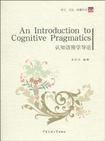认知语用学导论
出版时间:2010-3 出版社:中国传媒大学出版社 作者:李佐文 页数:274
前言
从研究语言到研究语言的使用是现代语言学的重要特征之一。语言作为人类重要交际工具,无时无刻不存在于人们的社会生活之中,是交流思想,抒发情感,沟通信息所必不可少的载体。研究不同语言交际环境下如何使用语言和理解语言的学科就是语用学。它从说话者和听话者的角度,把人们使用语言的交际行为看做是受各种社会文化因素制约的行为,研究特定语境中的话语含义,着重说明语境可能影响话语理解的各个方面,从而建立语用规则。 语言不仅是重要信息载体,也是人类的认知能力之一。人们进行言语交际的过程实质上就是认知的过程,即发话者明示自己的话语意图,听话者依据话语、语境假设,推导出发话者意图的过程。语用问题的认知研究是语言学研究的延伸和拓展。将交际视为一个认知过程,关注会话含义理解的认知参与因素及其作用,这就是认知语用学。语用学研究语言使用的规律,而语言符号本身是对认知方式的一种反映,是人们对客观事物的心理表征。因此,语用和认知密不可分。认知语用学就是根据认知科学的理论和方法来研究语言使用中的语用问题。 斯珀伯和威尔逊在合著的《关联性:交际与认知》(1986/1995)一书中提出的关联理论从认知心理的角度出发,认为交际理论又是一种认知理论,提出了明示一推理的交际模式,为认知语用学奠定了理论基础。本书在这一交际模式的基础上,详细探讨了认知语用学的背景与现状,研究方法,会话含义理论,各种交际模式的比较,认知语境,语用推理,明说与暗含,程序意义和概念意义,词汇语用以及关联理论对部分语言现象的解释力等问题,试图勾画出该学科的理论框架,反映出该领域的最新研究成果。同时本书用简明易懂的英语语言编写,以方便外语院系的研究生或语言学爱好者用作教材使用。
内容概要
从研究语言到研究语言的使用是现代语言学的重要特征之一。语言作为人类重要交际工具,无时无刻不存在于人们的社会生活之中,是交流思想,抒发情感,沟通信息所必不可少的载体。研究不同语言交际环境下如何使用语言和理解语言的学科就是语用学。它从说话者和听话者的角度,把人们使用语言的交际行为看做是受各种社会文化因素制约的行为,研究特定语境中的话语含义,着重说明语境可能影响话语理解的各个方丽,从而建立语用规则。
作者简介
李佐文,1966年生。中国传媒大学外国语学院院长,教授。博士后,英语语言文学专业硕士生导师;现任全国话语语言学研究会会长。研究方向为认知语用学、计算语言学。先后在《外国语》、《外语研究》等刊物发表学术论文三十余篇,出版专著、教材十余部。曾获全国“宝钢”教育奖和河北省“十大杰出青年教师”等荣誉称号。
书籍目录
Chapter 1 Cognitive Pragmatics.. An Overview 1. Introduction 2. An Overview of Pragmatics 3. From Philosophy of I.anguage to Cognitive Science 4. The Central Issues of Cognitive Pragmatics 5. The Approaches to Cognitive Pragmatics 6. The Relationship Between Cognilive Pragmatics and Cognitive Linguistics 7. The Developing Trends of Cognitive Pragmatics Chapter 2 Conversational Implicatures 1. Introduction 2. Meaning and Intention 3. Classic-Gricean Theory of Conversational Implicatures 4. Neo-Gricean Period 5. Development of Relevance Theory on Conversational Implicatures 6. Summary Chapter 3 Linguistic Communication and Its Models 1. Introduction 2. The Code Model of Linguistic Communication 3. The Inferential Model of Linguistic Communication 4. The Ostensive-inferential Model of I,inguistic Communication 5. Summary Chapter 4 Cognitive Context l. Introduction 2. Traditional Context 3. Cognitive Context 4. A Comparison Between Traditional Context and Cognitive Context 5. Cognitive Context in Communication 6. Summary Chapter 5 Cognitive Principle and Communicative Principle 1. Introduction 2. Relevance and Communication 3. The Principle of Relevance 4. Two Principles of Relevance 5. Summary Chapter 6 Pragmatic Inference 1. Introduction 2. Logical Inference 3. Features of Pragmatic Inference 4. The Dynamic Model of Pragmatic Inference 5. Bridging and Cognitive Inference 6. SummaryChapter 7 Explicature and lmplicature 1. Introduction 2. Traditional Distinction of"What is said" and "What is implied" 3. Relevance-theoretic Pragmatics 4. Pragmatic Tasks in Explicature Derivation 5. Summary Chapter 8 Conceptual Meaning and Procedural MeaningChapter 9 A Cog-pragmatic Study of Reference Assignment and Discourse MarkersChapter 10 Lexical PragmaticsIndex
章节摘录
Pragmatics,as many scholars describe, is an empirical science, but one with philosophical origins and philosophical import. References to pragmatics are found in philosophy since Charles Morris Foundations of the Theory of Signs was published in 1938,in which pragmaties is defined as the study of the relations between signs and their interpreters. Before Morris, Peirce was the primary source of the contemporary philosophical conception of "semiotic" as a general theory of representation and interpretation. Peireean semeiotic derives ultimately from the theory of signs of Duns Scotus and its later development by John of St. Thomas. In Peirces theory the sign relation is a triadic relation, a special species of thegenus.- the representing relation. According to Peirce, semiotic is aphenomenologically based and highly generalized critical theory —— alogic with application beyond the traditional domain to which logic in theordinary sense is restricted —— and can also be understood to be a generaltheory of interpretation which provides analytical instruments applicableto representation and significance of every sort with no privilege ofdistinctively linguistic conceptions. Peirces semiotic is primarilyoriented toward communication rather than language, and is distinct fromthe semiotics (originally called "semiologie" or "semiology) developed byextrapolation from the linguistics of Ferdinand de Saussure. Morris was concerned to outline the general shape of a science ofsigns, or semiotics. Within semiotics, Morris distinguished three distinctbranches of inquiry, syntactics, being the study of "the formal relationof signs to one another" , semantics , the study of "the relation of signs tothe objects to which the signs are applicable" , and pragmatics,the studyof "the relation of signs to interpreters" (1938.6).
图书封面
评论、评分、阅读与下载
用户评论 (总计1条)
- 写得不错,有见地
